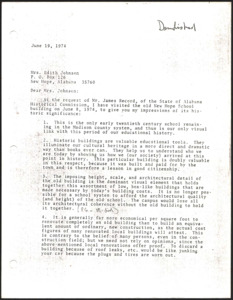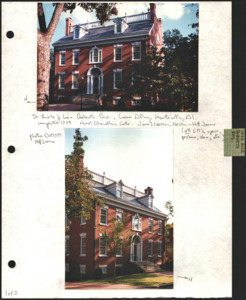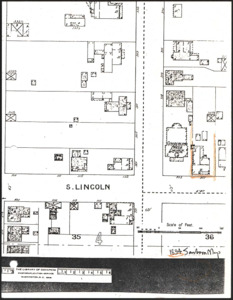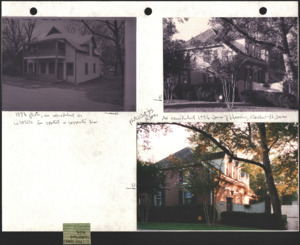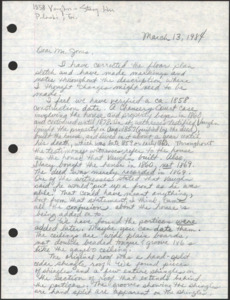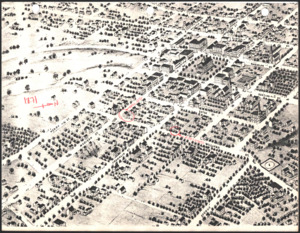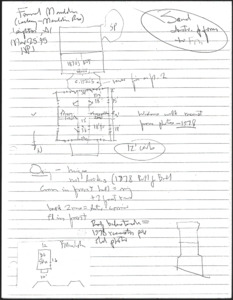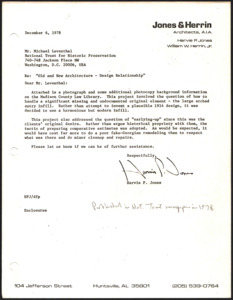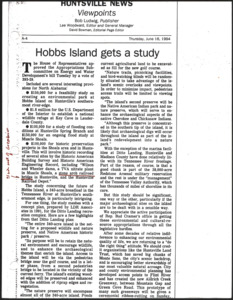
Browse Items (427 total)
Sort by:
-
Architecture notebook 60: New Hope High School, in New Hope, Alabama.
New Hope High School, built in the early twentieth century (c. 1920). Despite Harvie Jones' attempt to demonstrate the benefit of renovation, funds were unable to be raised and the school is demolished in 1975. Located in New Hope, Alabama. -
Architecture notebook 60: Dr. Hash Residence, at 514 E. Holmes Ave., Huntsville, Alabama.
Dr. Hash Residence, built c. 1870 and c. 1900. Renovation included a potting shed and three car garage. Located at 514 E. Holmes Ave., Huntsville, Alabama. -
Architecture notebook 60: Rick Roberts House, at 10 Cruse Alley, Huntsville, Alabama.
Rick Roberts Residence, built in 1995 by Jones and Herrin, Architects. Includes a terrace and courtyard. Located at 10 Cruse Alley, Huntsville, Alabama. -
Architecture notebook 60: Feeney-Brooks House, at 203 S. Lincoln St., Huntsville, Alabama.
Feeney-Brooks House, or the Miller House, built in 1829. Original structure added onto in 1861, and again in the eary 20th century. The house was demolished in 1983 by Central Presbyterian Church despite objections from the Huntsville Historical Preservation Commission, for an elaborate garden the Church never built. Located at 203 S. Lincoln St., Huntsville, Alabama. -
Architecture notebook 60: Haws Carriage House, at 606 Greene St., Huntsville, Alabama.
Haws carriage house, built c. 1900. Remodeled for rental or servants' house and again by Jones and Herrin, Architects in 1976. Located at 606 Greene St., Huntsville, Alabama. -
Architecture notebook 60: Vaughn-Stacy-Irwin House, at 111 Sam Davis Ave., Pulaski, Tennessee.
Vaughn-Stacy-Irwin House, built 1858. The property was bought by Vaughn in 1857. Classical Revival mid-19th century style, includes inspiration from Greek Revival, Palladian, and Italianate styles as well. A back addition was added in the late 19th century. Includes a 1880-1890 gazebo. Located at 111 Sam Davis Ave., Pulaski, Tennessee. -
Architecture notebook 60: Public Inn, at 205 Williams Ave., Huntsville, Alabama.
Public Inn, built c. 1818 at the northeast corner of Madison and Williams and moved to current site in November 1926. Opened to the public on October 29, 1819 by William E. Phillips. There was an addition in 1832. Built in the "Neo-Classical" style with English influences. Another addition to the rear of the houses was built in 1927 after it was moved. Restoration was completed in 1991. Located at 205 Williams Ave., Huntsville, Alabama. -
Architecture notebook 60: Leckey House, at southwest corner of AL 20 and Co. 48 (County Line), Leighton, Alabama.
Leckey House, or the Leckey-Mauldin house, built 1872-73 for Hugh C. Leckey, an Irish-born merchant. Single story home with Italiante style details. Renovated in 1991-1992 with additions made including a carport. Located at the southwest corner of AL 20 and Co. 48 (County Line), Leighton, Alabama. -
Architecture notebook 60: Law Library, at 205 East Side Square, Huntsville, Alabama.
Elbert H. Parsons Madison County Law Library, built 1914, was originally a Deparment store and an adult movie theater. A skylighted window was installed on the walkway in front of the building when c. 1830 brick was uncovered 12 inches below the present walkway. Located at 205 East Side Square, Huntsville, Alabama. -
Architecture notebook 60: Railroad Bridge, at Beaverdam Creek near AL 20, Greenbriar, Alabama.
Stone arch railroad Bridge, built 1873, presumably built from local limestone. Located at Beaverdam Creek near AL 20, Greenbriar, Alabama.
